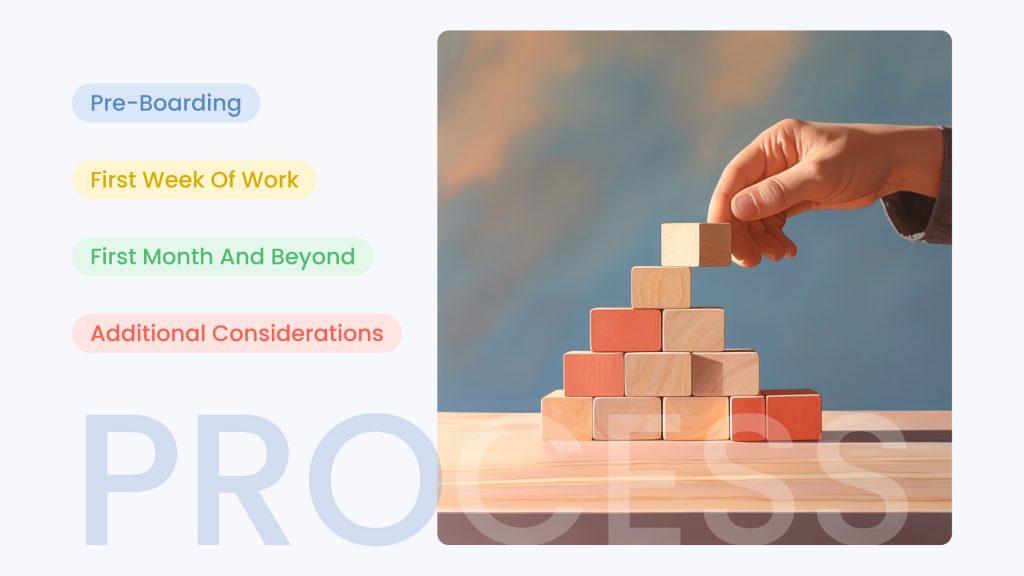Congratulations! You just hired the best talent for a role in your company. What’s next? Building the perfect employee onboarding process for your business needs, welcoming new employees, and ensuring they get the hang of everything their role entails. This is also the best time to clearly communicate the company values and expectations for their position.
The success of every employee mainly depends on the onboarding process. Many hiring managers and businesses, both large and small, sometimes fail to follow through after an employee accepts a job offer, getting too caught up in the hiring process.
This oversight can lead to a poor employee onboarding experience, which is often reduced to a simple email or a brief orientation. A well-structured onboarding process should help new hires connect with colleagues, access necessary resources, and understand their role expectations.
Based on recent workplace experiences, companies can no longer afford to throw employees into a job without proper support and guidance, expecting them to “sink or swim”. In this article, we’ll take you through how you can build an onboarding process from scratch and tools that can help streamline your work. Let’s dive in.
What is employee onboarding?
Employee onboarding is a process done by companies to integrate new hires into their roles and the company. Depending on the company, the onboarding process may involve introducing them to the company culture, values, policies, and procedures, as well as helping them build relationships with teammates and familiarizing them with the workplace.
Read next: Create a Memorable New Hire Orientation: Tips, Checklists, and Best HR Practices
Why is the employee onboarding process so important?
The employee onboarding process is both important for employers and employees — new employees are seamlessly integrated into their new environment and tools are provided to help them be more productive while employers are able to foster a positive workplace culture and reap the benefits of increased efficiency of work.
When employee onboarding is done excellently, everyone in the company has a lot to gain such as improved employee engagement, fostered collaboration, better administration, and promoted company culture. However, when done poorly, the new hire may struggle to integrate with its new workplace and tasks, especially in a remote environment.
Companies and HR managers put a lot of time and resources into attracting and hiring the best talents. It’s a great advantage to use employee onboarding as a tool to create a lasting relationship with new hires and improve the overall ROI of the organization.
Additional reading: Navigating the Digital Divide: Enhancing Remote Team Communication
Building Your Onboarding Process

Now that you know the basics of employee onboarding, it’s time to build your company’s onboarding process and maximize the time to make your new hires comfortable in their new role.
Pre-boarding
The employee onboarding process starts when you make your decision to hire a talent, that’s why pre-boarding is needed to prepare the company to receive a new employee.
- Offer acceptance
The pre-boarding phase starts from the moment the new talent signs the employment contract — showing that they accepted the job offer — to the first day on the job.
During this time, new hires are typically excited and eager to start their new role. Effective pre-boarding helps to sustain this enthusiasm and momentum, setting the stage for a successful onboarding experience.
- Pre-onboarding tasks
It’s important to maintain clear and transparent communication with new hires, especially if there’s a time gap between signing the offer letter and the employee’s official start date.
During this employee onboarding process, you can:
- Send necessary information in advance, including company brochure, employee handbook, company ethics, healthcare forms, company mission statement, policies, and more.
- Provide a welcome video or online tutorials pre-recorded by the HR or team lead for more information regarding the company and their new position.
- Invite the new employee to team outings or company events to build relationships with other team members before their first day.
- Complete necessary background checks and request for payroll and benefits information.
- Deliver the company’s swag package (branded t-shirts, stickers, mugs, journals, and so on).
Additional resources: 8 Key Onboarding Documents for Your New Hire Journey (with templates!)
First week of work
In the first week of work, new hires get to settle in and start contributing to the organization. Here are some things to do in this phase of the employee onboarding process:
- Warm welcome
Knowing how to welcome new employees is a skill every HR professional must learn. You can create a warm and friendly atmosphere for the new employees by introducing them to their team, providing a tour of the workplace, and letting them meet members of other teams.
- Allocate assets and set up access
Also, employers must ensure the new employee has all the necessary tools and resources to perform their job in their first week as a part of the employee onboarding process. This includes setting up access to relevant software, computers, and company networks.
- Provide an overview of the role and company
As an employer, you can provide comprehensive information to the new hire about their role, responsibilities, and expectations. This helps them understand the target and goals the company has set for them and work towards achieving it.
- Provide necessary training
Giving essential training sessions to equip the new employee with the skills and knowledge needed for their role is also important in the employee onboarding process. This can be new hire orientation, workshops, or online courses to give them a good headstart for the position.
First month and beyond
After the first month, it’s time to sit down with the new employee to properly evaluate their performance. Some companies do this in the first 90 days.
This form of performance review is specifically for the employee onboarding process and aims to assess the new hire’s past performance, highlight areas of improvement, and set goals for the upcoming quarter. It can also be used as a formality to signify the end of the new hire’s probation period, and to realign new expectations for their role.
During the first month of work, employers can:
- Offer ongoing training opportunities and support
The review allows the employer to learn how the new employee feels about the role and subsequently provide support needed for success.
- Schedule regular performance reviews
A performance review is important to gain insight into the new hire’s working experience, roadblocks faced, and develop strategies and goals to set them on the path for success. These regular check-ins signal to new hires that the organization prioritizes their well-being and in turn, boosts morale and employee satisfaction.
- Organize team-building activities or social events
Creating team bonding events for employees can help improve communication between teams, and increase overall productivity. Ensuring that there’s work-life balance further boosts employee retention and reduces the possibility of burnout.
Additional considerations
The onboarding process doesn’t just end after the first 90 days. It takes time before new employees are totally integrated in the company. Here are some additional steps you can include in your employee onboarding process:
- Encourage open communication
Creating an environment where new employees are comfortable to ask questions, share their concerns, and provide feedback is an important aspect of employee onboarding. Employers can encourage these communications through regular check-ins, open-door policies, and anonymous feedback channels.
- Set up a mentorship or buddy program
Pairing new employees with experienced colleagues who can offer guidance, support, and knowledge can help them scale through their first few months in the company. The assigned buddies should be able to provide a friendly face, answer questions, and help with the social integration of new hires.
- Recognize and celebrate successes
No one wants to keep working in a place where their labors are not acknowledged. You should celebrate the achievements and milestones of new employees, no matter how small. This can be public team recognition, rewards, or a genuine thank you from the team leads.
Tools to Streamline Your Onboarding Process
The employee onboarding process of new hires for HR takes a lot of time and effort that’s why tools are created to make the process significantly easier. Here are some employee onboarding software you can use to streamline the employee onboarding process for your company:
Project management software
Project management tools like Asana or Trello can be used by HR teams and managers to organize and assign tasks, set deadlines, and track progress throughout the employee onboarding process. The tools can help to create a structured and streamlined approach or reduce the risk of overlooking important steps in the process.
Learning management systems
There are platforms like Udemy, Innform, or TalentLMS that help companies create and deliver customized training programs such as video lessons, quizzes, and assessments. New hires can acquire the necessary skills and knowledge, and it’s a means of supporting the employee onboarding process.
Communication and collaboration tools
Communication and collaboration are needed in every employee onboarding process, tools like Slack, Microsoft Teams, or Google Workspace help with open communication, feedback, and teamwork among new hires, HR, and other teammates. There is also onboarding software that integrates with these tools.
Read next: Slack Tips and Tricks for More Productive HR Teams
Onboarding software
There are specialized software like Omni, that are designed specifically for employee onboarding, employee data management, and guiding new hires through the process step-by-step. These tools have robust features and automated workflows to make administrative tasks easier. This is effective for new employee engagement and productivity in the organization.
Achieve a Smoother Onboarding Journey with Omni

As you can see, the employee onboarding process is pivotal to ensure the seamless integration of your new hire into the organization. It is definitely not simple as there are countless action items to think about, tasks to follow up on, and paperwork to complete – even the most seasoned HR professional requires a strong system of organization to ensure a consistent and efficient employee onboarding experience.
HR automation allows HR teams and managers to easily track, schedule, and follow-up on the various tasks and documents required during an onboarding process. With Omni, you can access customizable email templates to welcome new employees, schedule and automate personalized onboarding communications, track and follow-up on important onboarding documents, and eliminate cumbersome manual processes like data entry that are prone to errors and delays.
Omni frees HR from the many time-consuming tasks of the onboarding process, and provides a consistent and uniform experience for new hires, all in one, easy-to-use system.
Schedule a chat with our team and learn about how Omni’s automated onboarding workflows can increase employee engagement, and give you back your valuable time to focus on strategic planning that drives business outcomes.


